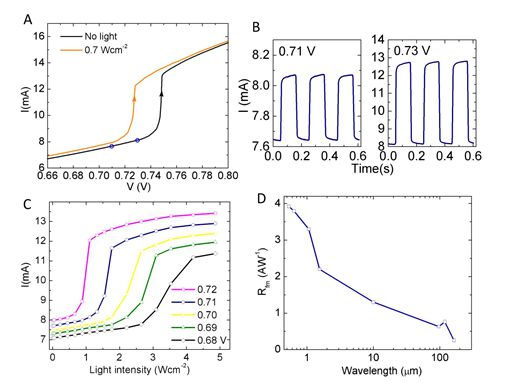China Instrument Network Instrument Development Recently, Dr. Wu Dong and his collaborators from the Wang Nanlin Research Group at the Center for Quantum Materials Science, Peking University, made a groundbreaking discovery regarding the ultra-wide spectral photoelectric response of 1T-TaS2, a two-dimensional charge-density wave (CDW) material, at room temperature. The team investigated the near-commensurate CDW state of 1T-TaS2 under ambient conditions and found that when the applied electric field is close to the threshold for CDW slip, the material becomes highly sensitive to light across a broad spectrum—from visible to terahertz. This finding opens up new possibilities for developing uncooled, ultra-wideband photodetectors, including those capable of detecting terahertz waves. The study was published in *Science Advances* as a Research Article (DOI: 10.1126/sciadv.aao3057, 2018), with Wu Dong and Wang Nanlin as co-authors.

Fig. 1T-TaS2 Ultra-wide spectrum photoelectric response characteristics. A. The effect of illumination on the IV curve. B. Switching effect of photocurrent. C. Photocurrent response of the device at λ = 1550 nm under different bias voltages. D. The magnitude of the optical responsivity (R) of the different bands near the threshold voltage.
The ability to convert optical signals into electrical signals is fundamental in photonics, with applications ranging from imaging and communication to quantum information and space science. However, achieving ultra-wide spectral detection—especially in the far-infrared and terahertz ranges—has long been a challenge. Conventional semiconductors, like silicon, are limited by their bandgap energy, making them transparent to lower-energy photons such as terahertz radiation. Metals, on the other hand, have no bandgap but suffer from high free carrier density, which often masks any photoresponse. Most traditional materials rely on single-particle excitation, limiting their sensitivity across a wide range of wavelengths.
In contrast, materials exhibiting collective excitations, such as charge density waves (CDWs), offer a different mechanism. CDWs involve both amplitude and phase modes of excitation. While amplitude mode affects the charge density without influencing current flow, phase mode corresponds to the sliding of the entire CDW, leading to charge transport. In ideal conditions, this motion could be resistance-free, but in real materials, impurities and defects pin the CDW, resulting in a finite resistance. When the applied electric field exceeds the threshold, the CDW slips, causing a sharp drop in resistance.
1T-TaS2, a two-dimensional CDW material, exhibits rich phase transitions as temperature decreases, from a metallic state to a near-commensurate CDW phase and finally to a commensurate insulating CDW phase. Wu Dong and his team observed that when the applied voltage is just below the CDW slip threshold, illumination can induce an early phase transition, resulting in a strong photoelectric response across a wide energy range—from ultraviolet to terahertz. This phenomenon paves the way for designing ultra-broadband photodetectors without the need for cooling.
The research involved collaboration with Prof. Ma Yongchang from Tianjin University of Technology and Prof. Zhao Ning from Tsinghua University, along with members of the Critical Research Group at the Center for Quantum Materials Science. The work was supported by the National Natural Science Foundation of China, the National Major Scientific Research Program, and the 2011 Plan Collaborative Innovation Center for Quantum Matter Science.
(Original title: *Science Advances reports Quantum Materials Science Center Wang Nanlin Research Group on the research of ultra-wide-spectrum photoelectric response of charge-density wave materials at room temperature*)Aluminum Paste For Aerated Brick
Technical Grade Aluminum paste,Aerated concrete Aluminum powder,Water-based Aluminum powder,Aerated brick Aluminum paste
Jiangsu Jiali New Material Technology Co., Ltd. , https://www.jlmaterial.com